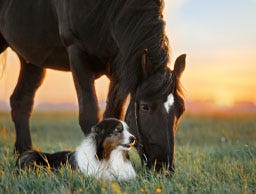How to Choose the Best Dog Toys
Toys are essential for any dog home, not just for exercise but also for enrichment, encouraging their natural behaviours and instincts in a safe, non-destructive way. While most dogs are not fussy when it comes to what they’ll play with, it's a key responsibility as a dog owner to ensure the toys you buy are safe and suitable for your dog.
In this blog, we take a look at some of the most common play styles for dogs and what to look out for when choosing the best dog toy.
Are All Dog Toys Safe?
There is no “one size fits all” regarding dog toys. It’s more about the individual dog and how they like to play. Some dogs are happy to nibble on the same old stuffed toy for years without it becoming a danger, while others will destroy whatever toy is given to them in a matter of moments.
To choose the best toy for your dog, you first need to consider their breed, instinctive behaviours, and play style, which will typically fall into one or more of the below:
- Active players — These dogs are all about getting moving, whether chasing a ball or just running rings around their owners until you finally call them inside.
- Thoughtful players — Many intelligent dog breeds get just as much (if not more) enrichment from using their brains as a means of play than running around, and likely enjoy training sessions, puzzles and anything that gets their brains going.
- Rough players — These kinds of dogs likely enjoy play fighting with other dogs or wrestling with their humans. They also tend to love their toys just a little too much and destroy whatever they’re given.
- Chewing players — Some dogs love to chew more than others and are just as happy with a rubber bone as they would be with any other toy.
As well as your dog’s favourite play time, it’s important to consider their breed and what they were bred for. For example, flat-faced breeds such as Shih Tzus or Pugs shouldn’t get too much exercise due to potential breathing difficulties, so active play should be kept to a minimum. Other breeds, such as Bulldogs or Chow Chows, aren’t bred for thinking and may find puzzle toys frustrating and grow bored.
Remember, every dog is different, regardless of their breed, so you may find that the “typical” toys recommended for your dog aren’t doing the trick, in which case, feel free to try other things and see what brings them the most joy.
Best Dog Toys for Active Dogs
Active dogs love to move, which makes toys like dog frisbees or the classic dog ball the perfect choice. These types of toys are also great for encouraging dogs with retrieving backgrounds to follow their instincts, as the toys are small enough to be carried back and thrown all over again.
If you really want to make the most of your dog’s exercise routines with toys, why not get creative and take them for a dip? Swimming is an excellent alternative to walking as it allows your dog to expend energy without putting too much strain on their joints, making it perfect for breeds predisposed to joint issues, like labradors and golden retrievers.
You can enhance their playtime, too, with our great range of dog water toys.

Puzzle Toys for Dogs
Most dogs were bred for a purpose, and in some cases, that purpose was to be quick and smart. If you have a particularly intelligent dog breed, such as a Border Collie or a German Shepherd, you may notice how hard it is to wear them out, even after over an hour of walking.
This is because intelligent dogs need mental stimulation as well as exercise. Interactive dog toys are the perfect choice for intelligent dogs as they encourage them to use their brains and other necessary skills like sniffing and searching. While these toys should not replace your dog's exercise routine, they are the perfect distraction between walks to keep them engaged.
Most dog puzzle toys come with various difficulties, so finding the level your dog can complete while still being a challenge. Treat toys like this KONG Wobbler™ Dog Toy is also a great way to encourage food-oriented dogs to try something new.

Best Toys for Dogs Who Play Rough
Some dogs were bred for their strength, and even if they have a sweet temperament, most of the time, when they play, they like to play rough. Whether by body slamming other dogs when playing fighting or tugging extra hard in the tug of war.
When it comes to picking toys for this kind of dog, the key thing you want to look for is durability. You need to ensure whatever toy you're giving them is built to last. For these kinds of dogs, we'd recommend tough rubber toys like the KONG® Extreme Dog Toy for chewing and strong rope toys like this KONG Rope To for rougher tug-of-war games, which can be played with yourself or even another dog.
When it comes to destructive dogs, avoid anything too soft or plush. With your dog's teeth and strength, there's a high chance it won't last more than one playtime, and there's an increased risk of your dog ingesting something they shouldn't, like buttons or stuffing.

Does Rough Play Make Dogs Aggressive?
Aggression in dogs is not something that can be easily defined by a single action. Even the friendliest dogs might display aggressive behaviours when their boundaries are crossed, whether by another dog or a human. The most important thing is to recognise when a warning is going to escalate by understanding your dog's body language.
Puppies fight with their littermates from as young as two weeks, and it’s an essential part of their social development. It teaches them bite inhibition and provides the foundation for how to initiate play with other dogs. While it may seem rough to us with all the snarling and snapping, play fighting is perfectly normal for dogs and, in fact, enjoyable for them.
Are My Dogs Fighting or Playing?
Dog play fighting can be intense, so it’s no wonder so many people ask this question. If you’re concerned whether your dogs are play fighting or actually fighting, look out for the following:
- Are the dogs taking turns being submissive or dominant? When playing, dogs will often deliberately drop onto their backs or let themself get caught to continue the game.
- Are they making exaggerated movements? Dogs who are playing will act (and look) rather silly. They’ll bow to each other, slam their paws on the floor, or maybe even smack the other dog with a paw.
- Are they growling loudly? Play growling is a big part of the play and is often wildly exaggerated and comes with bouncy movements and a silly dog grin. An aggressive growl, however, is accompanied by a stiff body, ears flat to the head, and lips pulled back with teeth bared.
- Are they coming back for more? Most real dog fights end with the loser trying to leave the area fast, likely with their tail tucked. Dogs who are playing will try to keep the game going and come back for more.

While rough play itself isn't a problem, there are things to be wary of:
- Make sure both dogs want to play, or your dog might get an aggressive reaction when attempting to play.
- Don’t let any dogs be ganged up on — play should be fair and equal on all sides, not a traumatic experience.
- Consider your dog’s size. Some dogs, lovely as they are, don’t realise their own size and strength. If they play with another dog, this could result in accidental injury, which nobody wants.
- Always observe dogs playing rough and look for any early signs of aggression from either dog. If you think things will escalate, it’s always better to intrude on dogs playing than dogs fighting.
Chew Toys for Dogs
Every dog should have some kind of dog chew toy available to them regardless of their play style. Chewing is instinctive for them, and without a proper outlet, they might turn that instinct towards your home, furniture, or even dangerous things like power cables.
Each dog is different, so while many chew toys available are safe for dogs to chew, there are some key things to remember when choosing the best chew toy for your dog:
- The size of the toy — anything that could be easily swallowed by your dog is not suitable for chewing, and the same goes for anything too big for them to properly fit in their jaw.
- The materials used — not all materials are safe for dogs to chew or may be made with parts (such as stuffing) that could be dangerous if accidentally ingested.
- The toy’s durability — Toys that are too hard for your dog can cause damage to their teeth, while weaker toys might easily break apart and become a choking hazard.
If you’re concerned about your dog eating their chew toys, then why not try an alternative like a natural dog chew treat to keep them occupied? Just make sure to follow our dog chew safety advice to ensure you’re choosing the right one.
No dog toy is meant to last forever, but by making the right choice early on, you can ensure that your dog is getting the most out of their toys physically and mentally. If you’re looking to treat your dog to a new toy, why not take a look at our complete range of dog toys available from top brands like KONG, Nylabone, Beco, and more?






























